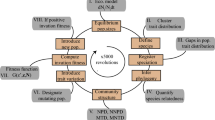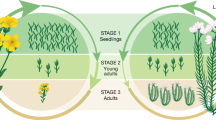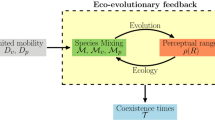Abstract
Competition can result in evolutionary changes to coexistence between competitors but there are no theoretical models that predict how the components of coexistence change during this eco-evolutionary process. Here we study the evolution of the coexistence components, niche overlap and competitive differences, in a two-species eco-evolutionary model based on consumer–resource interactions and quantitative genetic inheritance. Species evolve along a one-dimensional trait axis that allows for changes in both niche position and species intrinsic growth rates. There are three main results. First, the breadth of the environment has a strong effect on the dynamics, with broader environments leading to reduced niche overlap and enhanced coexistence. Second, coexistence often involves a reduction in niche overlap while competitive differences stay relatively constant or vice versa; in general changes in competitive differences maintain coexistence only when niche overlap remains constant. Large simultaneous changes in niche overlap and competitive difference often result in one of the species being excluded. Third, provided that the species evolve to a state where they coexist, the final niche overlap and competitive difference values are independent of the system’s initial state, although they do depend on the model’s parameters. The model suggests that evolution is often a destructive force for coexistence due to evolutionary changes in competitive differences, a finding that expands the paradox of diversity maintenance.
This is a preview of subscription content, access via your institution
Access options
Access Nature and 54 other Nature Portfolio journals
Get Nature+, our best-value online-access subscription
$29.99 / 30 days
cancel any time
Subscribe to this journal
Receive 12 digital issues and online access to articles
$119.00 per year
only $9.92 per issue
Buy this article
- Purchase on Springer Link
- Instant access to full article PDF
Prices may be subject to local taxes which are calculated during checkout





Similar content being viewed by others
Data availability
Code (including Shiny App) and data to replicate our analyses are available at: https://github.com/aipastore/CoexistenceTheory.
Code availability
Code (including Shiny App) to replicate our analyses are available at: https://github.com/aipastore/CoexistenceTheory.
References
Weber, M. G., Wagner, C. E., Best, R. J., Harmon, L. J. & Matthews, B. Evolution in a community context: on integrating ecological interactions and macroevolution. Trends Ecol. Evol. 32, 291–304 (2017).
TerHorst, C. P. et al. Evolution in a community context: trait responses to multiple species interactions. Am. Nat. 191, 368–380 (2018).
Vellend, M. et al. Conceptual synthesis in community ecology. Q. Rev. Biol. 85, 183–206 (2010).
Post, D. M. & Palkovacs, E. P. Eco-evolutionary feedbacks in community and ecosystem ecology: interactions between the ecological theatre and the evolutionary play. Philos. Trans. R. Soc. B 364, 1629–1640 (2009).
Hiltunen, T., Hairston, N. G., Hooker, G., Jones, L. E. & Ellner, S. P. A newly discovered role of evolution in previously published consumer–resource dynamics. Ecol. Lett. 17, 915–923 (2014).
Vasseur, D.A., Amarasekare, P., Rudolf, V.H.W. & Levine, J.M. Eco-evolutionary dynamics enable coexistence via neighbor-dependent selection. Am. Nat. 178, E96–E109 (2011).
Barabás, G. & D’Andrea, R. The effect of intraspecific variation and heritability on community pattern and robustness. Ecol. Lett. 19, 977–986 (2016).
Chesson, P. Mechanisms of maintenance of species diversity. Annu. Rev. Ecol. Syst. 31, 343–366 (2000).
Adler, P. B., HilleRislambers, J. & Levine, J. M. A niche for neutrality. Ecol. Lett. 10, 95–104 (2007).
Chesson, P. in Ecological Systems (ed. Leemans, R.) Ch. 13 (Springer, 2013).
Chesson, P. Updates on mechanisms of maintenance of species diversity. J. Ecol. 106, 1773–1794 (2018).
Barabás, G., D’Andrea, R. & Stump, S. M. Chesson’s coexistence theory. Ecol. Monogr. 88, 277–303 (2018).
Germain, R. M., Williams, J. L., Schluter, D. & Angert, A. L. Moving character displacement beyond characters using contemporary coexistence theory. Trends Ecol. Evol. 33, 74–84 (2018).
Germain, R. M., Srivastava, D. & Angert, A. L. Evolution of an inferior competitor increases resistance to biological invasion. Nat. Ecol. Evol. 4, 419–425 (2020).
Adler, P. B., Ellner, S. P. & Levine, J. M. Coexistence of perennial plants: an embarrassment of niches. Ecol. Lett. 13, 1019–1029 (2010).
Bimler, M. D., Stouffer, D. B., Lai, H. R. & Mayfield, M. M. Accurate predictions of coexistence in natural systems require the inclusion of facilitative interactions and environmental dependency. J. Ecol. 106, 1839–1852 (2018).
Wainwright, C. E., HilleRisLambers, J., Lai, H. R., Loy, X. & Mayfield, M. M. Distinct responses of niche and fitness differences to water availability underlie variable coexistence outcomes in semi-arid annual plant communities. J. Ecol. 107, 293–306 (2018).
Hubbell, S. P. The Unified Neutral Theory of Biodiversity and Biogeography (Princeton Univ. Press, 2001).
Leibold, M. A. & McPeek, M. A. Coexistence of the niche and neutral perspectives in community ecology. Ecology 87, 1399–1410 (2006).
Song, C., Barabás, G. & Saavedra, S. On the consequences of the interdependence of stabilizing and equalizing mechanisms. Am. Nat. 194, 627–639 (2019).
Taper, M. L. & Case, T. J. Quantitative genetic models for the coevolution of character displacement. Ecology 66, 355–371 (1985).
Taper, M. L. & Case, T. J. Models of character displacement and the theoretical robustness of taxon cycles. Evolution 46, 317–333 (1992).
Schreiber, S. J., Bürger, R. & Bolnick, D. I. The community effects of phenotypic and genetic variation within a predator population. Ecology 92, 1582–1593 (2011).
Lankau, R. A. Rapid evolutionary change and the coexistence of species. Annu. Rev. Ecol. Evol. Syst. 42, 335–354 (2011).
D’Andrea, R. & Ostling, A. Challenges in linking trait patterns to niche differentiation. Oikos 125, 1369–1385 (2016).
Abrams, P. A. The theory of limiting similarity. Annu. Rev. Ecol. Syst. 14, 359–376 (1983).
Stuart, Y. E. & Losos, J. B. Ecological character displacement: glass half full or half empty? Trends Ecol. Evol. 28, 402–408 (2013).
Zhao, L., Zhang, Q. G. & Zhang, D. Y. Evolution alters ecological mechanisms of coexistence in experimental microcosms. Funct. Ecol. 30, 1440–1446 (2016).
Hart, S. P., Turcotte, M. M. & Levine, J. M. Effects of rapid evolution on species coexistence. Proc. Natl Acad. Sci. USA 116, 2112–2117 (2019).
Slatkin, M. Ecological character displacement. Ecology 61, 163–177 (1980).
Rummel, J. D. & Roughgarden, J. D. A theory of faunal buildup for competition communities. Evolution 39, 1009–1033 (1985).
MacArthur, R. & Levins, R. The limiting similarity, convergence, and divergence of coexisting species. Am. Nat. 101, 377–385 (1967).
Abrams, P. A. Alternative models of character displacement and niche shift. I. Adaptive shifts in resource use when there is competition for nutritionally nonsubstitutable resources. Evolution 41, 651–661 (1987).
TerHorst, C. P., Miller, T. E. & Powell, E. When can competition for resources lead to ecological equivalence? Evol. Ecol. Res. 12, 843–854 (2010).
May, R. M. Stability in multispecies community models. Math. Biosci. 12, 59–79 (1971).
May, R. M. Will a large complex system be stable? Nature 238, 413–414 (1972).
McPeek, M. A. Limiting similarity? The ecological dynamics of natural selection among resources and consumers caused by both apparent and resource competition. Am. Nat. 193, E92–E115 (2019).
Pásztor, L., Barabás, G. & Meszéna, G. Competitive exclusion and evolution: convergence almost never produces ecologically equivalent species. Am. Nat. 195, E112–E117 (2020).
Mayfield, M. M. & Levine, J. M. Opposing effects of competitive exclusion on the phylogenetic structure of communities. Ecol. Lett. 13, 377–385 (2010).
Connell, J. H. Diversity and the coevolution of competitors, or the ghost of competition past. Oikos 35, 131–138 (1980).
Vukics, A., Asbóth, J. & Meszéna, G. Speciation in multidimensional evolutionary space. Phys. Rev. E 68, 041903 (2003).
Dieckmann, U. & Doebeli, M. On the origin of species by sympatric speciation. Nature 400, 354–357 (1999).
May, R. M. Stability and Complexity in Model Ecosystems (Princeton Univ. Press, 1973).
Meszéna, G., Gyllenberg, M., Pásztor, L. & Metz, J. A. J. Competitive exclusion and limiting similarity: a unified theory. theoretical population biology. Theor. Popul. Biol. 69, 68–87 (2006).
Godoy, O., Kraft, N. J. B. & Levine, J. M. Phylogenetic relatedness and the determinants of competitive outcomes. Ecol. Lett. 17, 836–844 (2014).
Kraft, N. J. B., Godoy, O. & Levine, J. M. Plant functional traits and the multidimensional nature of species coexistence. Proc. Natl Acad. Sci. USA 112, 797–802 (2015).
Bono, L. M., Gensel, C. L., Pfennig, D. W. & Burch, C. L. Competition and the origins of novelty: experimental evolution of niche-width expansion in a virus. Biol. Lett. 9, 2012.0616 (2013).
Stuart, Y. E. et al. Rapid evolution of a native species following invasion by a congener. Science 346, 463–466 (2014).
Zuppinger-Dingley, D. et al. Selection for niche differentiation in plant communities increases biodiversity effects. Nature 515, 108–111 (2014).
Ellis, C. N., Traverse, C. C., Mayo-Smith, L., Buskirk, S. W. & Cooper, V. S. Character displacement and the evolution of niche complementarity in a model biofilm community. Evolution 69, 283–293 (2015).
Peterson, M. L., Rice, K. J. & Sexton, J. P. Niche partitioning between close relatives suggests trade-offs between adaptation to local environments and competition. Ecol. Evol. 3, 512–522 (2013).
Agnarsson, I., Gotelli, N. J., D., A. & Kuntner, M. Limited role of character displacement in the coexistence of congeneric Anelosimus spiders in a Madagascan montane forest. Ecography 39, 743–753 (2016).
Fišer, C., Luštrik, R., Sarbu, S., Flot, J. F. & Trontelj, P. Morphological evolution of coexisting amphipod species pairs from sulfidic caves suggests competitive interactions and character displacement, but no environmental filtering and convergence. PLoS ONE 10, e0123535 (2015).
Miller, T. E., Moran, E. R. & TerHorst, C. P. Rethinking niche evolution: experiments with natural communities of Protozoa in pitcher plants. Am. Nat. 184, 277–283 (2014).
Tilman, D. Resource Competition and Community Structure (Princeton Univ. Press, 1982).
Abrams, P. A. The evolution of predator–prey interactions: theory and evidence. Annu. Rev. Ecol. Syst. 31, 79–105 (2000).
Hairston, N. G., Ellner, S. P., Geber, M. A., Yoshida, T. & Fox, J. A. Rapid evolution and the convergence of ecological and evolutionary time. Ecol. Lett. 8, 1114–1127 (2005).
Falster, D. S., Brännström, Å, Westoby, M. & Dieckmann, U. Multitrait successional forest dynamics enable diverse competitive coexistence. Proc. Natl Acad. Sci. USA 114, E2719–E2728 (2017).
Lande, R. & Arnold, S. J. The measurement of selection on correlated characters. Evolution 37, 1210–1226 (1983).
Bulmer, M. G. The Mathematical Theory of Quantitative Genetics (Clarendon Press, 1980).
Barton, N. H., Etheridge, A. M. & Véber, A. The infinitesimal model: definition, derivation, and implications. Theor. Popul. Biol. 118, 50–73 (2017).
Turelli, M. Commentary: Fisher’s infinitesimal model: a story for the ages. Theor. Popul. Biol. 118, 46–49 (2017).
MacArthur, R. H. Species packing and competitive equilibria for many species. Theor. Popul. Biol. 1, 1–11 (1970).
Chesson, P. MacArthur’s consumer–resource model. Theor. Popul. Biol. 37, 26–38 (1990).
Falconer, D. S. Introduction to Quantitative Genetics (Longman, 1981).
Acknowledgements
We thank S. Allesina, R. Bertram, B. Inouye, S. Steppan and A. Winn for providing insightful comments on this work. This work was made possible in part by funding awarded to M.M.M. (DP170100837) by the Australian Research Council. G.B. acknowledges funding by the Swedish Research Council (Vetenskapsrådet), grant VR 2017-05245.
Author information
Authors and Affiliations
Contributions
A.I.P. and G.B. designed the study, carried out analyses and drafted the manuscript. M.D.B. carried out analyses and helped draft the manuscript. M.M.M. contributed to the interpretation of analyses and critically revised the manuscript. T.E.M. contributed to the design of the study and critically revised the manuscript.
Corresponding author
Ethics declarations
Competing interests
The authors declare no competing interests.
Additional information
Peer review information Nature Ecology & Evolution thanks J. Sakarchi and the other, anonymous, reviewer(s) for their contribution to the peer review of this work. Peer reviewer reports are available.
Publisher’s note Springer Nature remains neutral with regard to jurisdictional claims in published maps and institutional affiliations.
Supplementary information
Supplementary Information
Supplementary information on methods.
Rights and permissions
About this article
Cite this article
Pastore, A.I., Barabás, G., Bimler, M.D. et al. The evolution of niche overlap and competitive differences. Nat Ecol Evol 5, 330–337 (2021). https://doi.org/10.1038/s41559-020-01383-y
Received:
Accepted:
Published:
Issue Date:
DOI: https://doi.org/10.1038/s41559-020-01383-y
This article is cited by
-
Distribution and dynamics of niche and interspecific association of dominant phytoplankton species in the Feiyun River basin, Zhejiang, China
Journal of Oceanology and Limnology (2024)
-
Mechanisms shaping the functional diversity of birds’ composition in the primeval forest ecosystem of the Białowieża National Park
European Journal of Forest Research (2024)
-
Trophic niche diversity and redundancy across trophic positions in a subtropical river fish assemblage
Hydrobiologia (2024)
-
Trophic niche variation and overlap between invasive mrigal carp and native mud carp in southern China
Biological Invasions (2024)
-
Niche differentiation and higher uptake of available nitrogen maintained the productivity of alpine meadow at early degradation
Biology and Fertility of Soils (2023)



